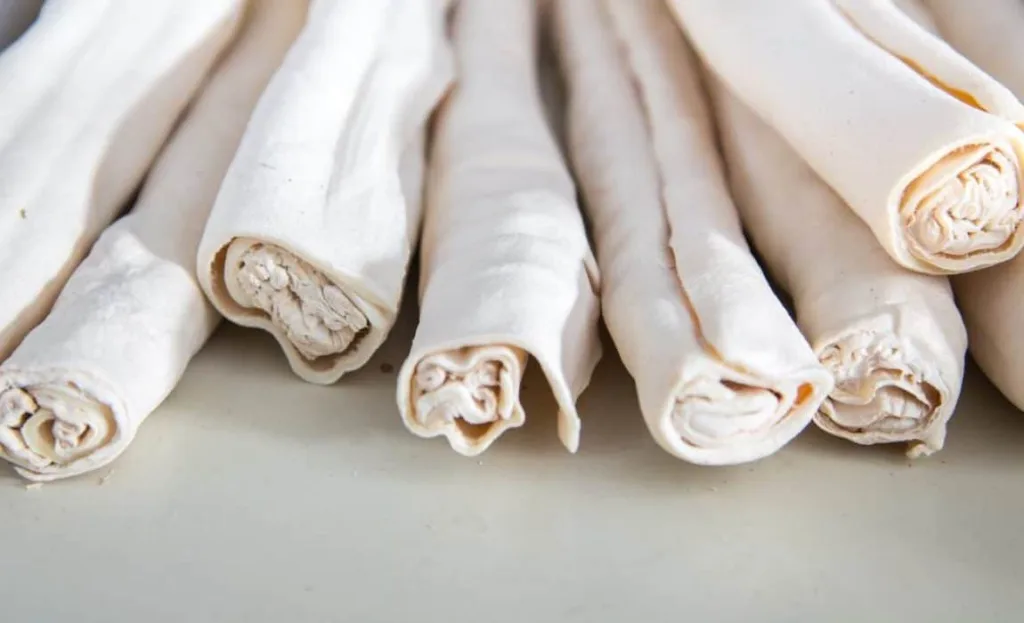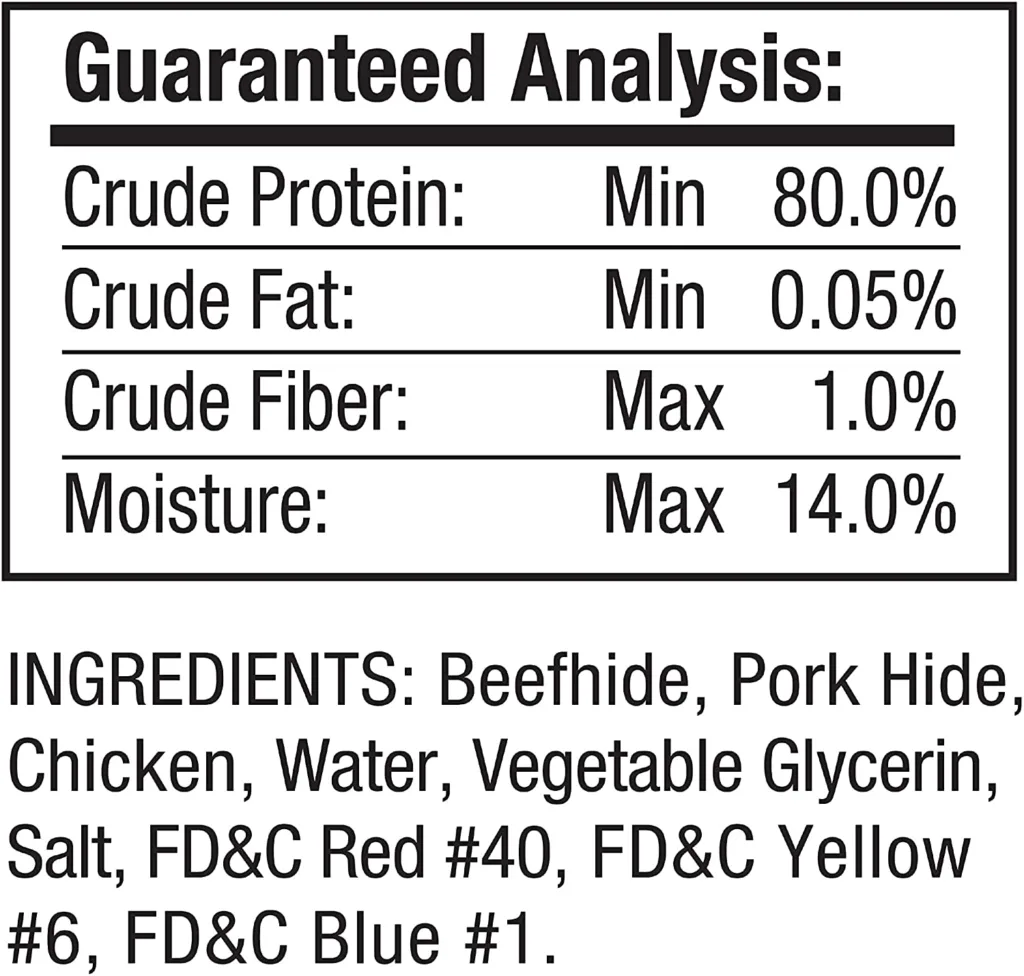Rawhide treat is a popular choice for dogs, and there are plenty of varieties to satisfy their natural desire to chew.However, depending on what you hear, you may be wondering if Rawhide Treat is good and safe for your puppy.
Table of Contents
As dog owners, we often find ourselves wandering the aisles of pet stores or scrolling through online marketplaces, looking for the perfect treat to keep our furry friends both happy and healthy. Among the plethora of options, rawhide treats have long been a staple. But are they truly the benign pleasure we believe them to be?
I remember the day I introduced a rawhide bone to my own dog, expecting it to be a source of endless fun. Instead, it sparked a journey into the heart of what rawhide is and whether it belongs in the mouths of our canine companions.
To help you decide if Rawhide is right for your dog, let’s find out the facts in this controversial treat.
What is a Rawhide Treat?

Rawhide is more than just a dog treat; it’s a byproduct of the leather industry with a rich history and a variety of uses. The journey from hide to rawhide is a complex one, involving several steps that transform the animal skin into the stiff, chewable product many dogs enjoy.
Manufacturing Process:
- Preparation: The process begins with the skin of animals, typically cattle, which is sourced from the meat industry. The skin is first cleaned, removing all fur, meat, and fat.
- Curing: The cleaned hide is then soaked in a solution, often containing lime, to help separate the hair and fat from the skin.
- Stretching: After soaking, the hide is stretched over a frame to ensure it dries evenly and maintains its shape.
- Drying: The stretched hide is left to dry, resulting in a hard and translucent material.
- Cutting: Once dried, the rawhide is cut into various shapes and sizes, depending on its intended use.
- Finishing: The final step often involves additional treatments, such as bleaching or flavoring, especially for rawhide intended for dog chews.
Rawhide Ingredients & Manufacturing
Contents of Rawhide: Rawhide primarily consists of collagen, a type of protein that’s abundant in the connective tissues of animals. It’s this collagen that gives rawhide its strength and durability. However, during the manufacturing process, rawhide may also come into contact with various chemicals used for cleaning and preservation. These can include:
- Lime: Used in the curing process to help remove hair and fat.
- Bleach: Sometimes used to whiten the rawhide and make it more visually appealing.
- Flavorings: Often added to make the rawhide more enticing to dogs.
Considerations: While rawhide can be a long-lasting chew for dogs, it’s important to be aware of the potential risks associated with its production. The use of chemicals in the process can lead to concerns about ingestion and the overall safety of the treat. Additionally, the physical properties of rawhide, such as its stiffness and potential to splinter, can pose choking hazards or cause digestive blockages.

Since rhubarb is an animal product, it is important to chew and focus on where the source is.
Also Read: How to feed royal canin maxi starter to a puppy?
If you and your dog choose crude hydrides, all-natural, digestible. Look for the ones made in, which meet strict production standards.
Digestion
Digesting the Rawhide depends on your dog and chewing the rhubarb. In general, most Rawhide is not easily digested.
Any pieces your dog picks up will not break down like their food and their digestive system is likely to crumble. For large and small dogs, these intact parts pose a risk of choking – more on the ones below.
Choking
Rheumatoid arthritis can be treated as a long-term treatment to break your dog into smaller.
However, if your dog can bite into large chunks, there is a chance that these fragments may be choking or clogging the gut.
If your dog has a strong chewing gum and usually breaks tough toys easily, you may be looking for alternatives to satisfy their craving.

As always, when giving your pet a new toy or dog dinner, it’s a good idea to keep an eye on them and monitor their play.
We also recommend removing any chewing gum when it becomes small enough to swallow and replacing it with a new, larger piece.
Pros and Cons of Rawhide Treats
The advantages of rawhide are often touted by manufacturers and retailers. They’re said to promote dental health by reducing tartar and plaque, and they satisfy a dog’s natural urge to chew, which can be a stress-reliever and a boredom-buster.
Yet, the disadvantages are significant and worth considering. Choking hazards, gastrointestinal blockages, and the potential for contamination with pathogens like salmonella or E. coli are serious risks. Moreover, not all dogs digest rawhide easily, which can lead to internal obstructions and require emergency veterinary care.
| Pros | Cons |
|---|---|
| Dental Health: Rawhide can help reduce plaque and tartar buildup, promoting better dental hygiene. | Choking Hazard: Pieces can break off and become lodged in the throat or digestive tract. |
| Entertainment: Provides mental stimulation and can keep a dog occupied for hours. | Digestive Issues: Not all dogs digest rawhide well, which can lead to gastrointestinal blockages. |
| Behavioral Benefits: Can deter dogs from chewing on inappropriate items like furniture. | Chemical Contamination: Rawhide processing may involve harmful chemicals that could be ingested. |
| Variety: Comes in different sizes and shapes to suit various dog breeds and preferences. | Bacterial Contamination: There’s a risk of salmonella or E. coli contamination, which can affect both pets and humans. |
| Gum Health: Chewing rawhide can stimulate gums and reduce the risk of gum diseases. | Quality Variance: The quality of rawhide can vary greatly, with some being more processed than others. |
Common Misconceptions
There’s a pervasive belief that rawhide is a completely natural and digestible treat for dogs. This misconception can lead to owners feeling confident in their choice without understanding the potential consequences. In reality, rawhide is often processed with chemicals and can be difficult for dogs to digest. It’s important to recognize that ‘natural’ doesn’t always equate to ‘safe’ or ‘healthy.’
Alternatives to Rawhide Treats
When it comes to alternatives to rawhide treats, dog owners have a variety of options that can be safer and healthier for their pets. Here are some popular alternatives, along with reasons why they are considered better choices and the ingredients they contain:
1. Himalayan Yak Chews
- Why a Good Alternative: These chews are known for their long-lasting nature and are highly digestible. They are often an excellent hypo-allergenic option, making them suitable for dogs with sensitivities.
- Ingredients: Primarily made from yak milk, some may also contain cow’s milk, salt, and lime juice. It’s important to check the label for any additional ingredients.
2. Bully Sticks
- Why a Good Alternative: Bully sticks are less processed than rawhide and are more easily digested by dogs. They are also rich in amino acids, which can help keep your dog’s teeth clean.
- Ingredients: Made from bull penises, these treats are a single-ingredient product, which means they don’t contain any artificial chemicals or preservatives.
3. Tendon Chews
- Why a Good Alternative: Tendon chews are smaller and easier to digest compared to rawhide. They are also beneficial for joint health as they contain glucosamine, elastin, chondroitin, and collagen.
- Ingredients: These chews are made from animal tendons, such as beef, turkey, or ostrich, and do not typically contain additional ingredients.
4. Tripe Sticks
- Why a Good Alternative: Tripe sticks are made from the lining of a cow’s stomach and are highly digestible, making them ideal for dogs with sensitive stomachs. They are also lower in calories.
- Ingredients: The main ingredient is the stomach lining of cows, and they are generally free from artificial additives.
These alternatives not only provide a safer chewing experience for dogs but also offer additional health benefits that rawhide does not. It’s always recommended to supervise your dog while they enjoy any chew treat and to consult with a veterinarian if you have concerns about which treats are best for your dog’s health.
Should some dogs avoid Rawhide Treat?
Does your dog have a history of diarrhea or other digestive problems after chewing Rawhide treat? Or does your dog run the risk of swallowing large chunks of Rawhide, clogging them up?
If so, try alternatives to satisfy your dog’s desire to keep teeth clean and chewed.
Talk to your veterinarian or pet store dealer. Describe your pet’s size, personality, and needs to identify what works best for you.
Sometimes hard rubber chewing works well. You can fill it with food like some kind of peanut butter to keep your dog interested and occupy them.
Whether or not your dog has problems with rawhide treats, you can try a variety of chewing gum treats and toys, including green, natural marrow bones, and hard rubber toys to fully satisfy your dog’s chewing and other needs.
Assessing Your Dog’s Individual Needs
Understanding your dog’s specific needs is crucial when selecting treats. Some dogs are aggressive chewers and may need more durable options, while others have sensitive stomachs that require easily digestible choices. Consulting with a veterinarian can provide guidance tailored to your dog’s health, ensuring that their treats are both safe and enjoyable.
Personal Experiences and Recommendations
In my years as a dog owner, I’ve learned that the best treat is one that suits my dog’s individual needs and one that I feel confident giving. Through trial and error, I’ve found that high-quality, limited-ingredient treats are often the safest bet. I recommend always supervising your dog when they’re enjoying a chew and being vigilant about the size and condition of the treat to prevent any accidents.
Conclusion
The debate over rawhide is not a simple one, but it’s clear that there are valid concerns about its safety. As responsible dog owners, it’s our duty to weigh the pros and cons and make informed decisions about what we allow our dogs to chew. By exploring alternatives and consulting with professionals, we can ensure that our dogs have access to enjoyable, safe treats that contribute to their overall well-being.

